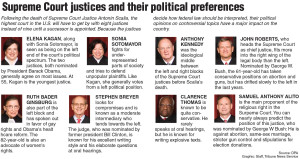By Timothy Cho
Editor-in-Chief
In the wake of former Supreme Court Justice Antonin Scalia’s death, the balance within the Supreme Court is now in question, especially with the upcoming election quickly approaching. While Senators struggle to find a compromise with the President, the Supreme Court itself is put in an awkward, but not uncommon, situation.
Formerly consisting of nine justices, the current court, with eight justices, are evenly split in terms of political ideology; John Roberts, Anthony Kennedy, Clarence Thomas and Samuel Alito stand for generally conservative beliefs and interpretations of the Constitution, while Ruth Bader Ginsburg, Stephen Breyer, Sonia Sotomayor and Elena Kagan represent the liberal beliefs.
This even divide presents an issue for those attempting to resolve their lawsuits at the Supreme Court–if the justices vote four-to-four, then the case does not continue in the Supreme Court and the decision made by the lower court stands as the final decision.
Thus, controversial and potentially ground-breaking cases, like those regarding abortion or religion, may end in a stalemate in the Supreme Court and be resolved by the lower court’s ruling.
However, there stands a greater problem. In the American government structure, there are three branches of power: the executive branch (President and the White House), the legislative branch (Senate and House of Representatives) and the judicial branch (Supreme Court).
What happens to one branch has an effect on the other two branches, and this relationship is being exemplified right now.
Under the Constitution, when there exists a vacancy in the Supreme Court, it is the President’s responsibility to nominate a candidate to fulfill that vacant position and the Senate is responsible for either allowing or denying the chosen candidate their position as a justice.
However, the current Senate is composed of a Republican majority, and many Republican Senators have made it clear that they will oppose whoever President Barack Obama decides to nominate. Thus, a stalemate is reached between the executive and legislative branches, at the expense of the judicial branch.
The likely result is that no justice will rise to the vacant position until the elections come to an end in November. For now, the President and Congress will continue to conflict, while the Supreme Court will continue its session with eight justices.







